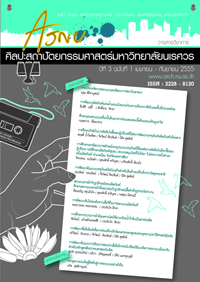การพัฒนาเส้นใยของต้นจากเพื่อใช้ในการออกแบบผลิตภัณฑ์
Main Article Content
Abstract
การวิจัยนี้มีวัตถุประสงค์ เพื่อศึกษาข้อมูลการใช้ประโยชน์ของต้นจาก และเพื่อศึกษาทดลองพัฒนากระบวนการผลิตงานหัตถกรรมจากเส้นใยจากเพื่อนำมาเป็นแนวทางในการพัฒนาผลิตภัณฑ์หัตถกรรม และประเมินผลความเหมาะสมของผลิตภัณฑ์จากกลุ่มตัวอย่าง คือ ผู้ผลิต ผู้จำหน่าย และผู้บริโภคผลิตภัณฑ์จากเส้นใยพืช ด้วยเครื่องมือแบบสอบถาม โดยใช้กลุ่มตัวอย่างจำนวน 60 คน
ผลการศึกษาพบว่า ส่วนของต้นจากที่สามารถนำมาใช้ประโยชน์ได้แก่ส่วนของใบ ก้านใบ โคนก้านใบ ก้านช่อดอก ก้านช่อผล ดอก และ ผล ส่วนของโคนก้านใบต้นจากมีเส้นใยที่สามารถนำมาแปรรูปด้วยการฟั่นเป็นเส้นเชือกและนำไปใช้ประโยชน์เป็นวัสดุในงานหัตถกรรมถัก ทอ และสานได้ ในการพัฒนาคุณภาพของเส้นใยจากได้ทดลองนำเส้นใยจากไปผสมเส้นใยพืชอื่น ได้แก่ ป่านศรนารายณ์ ผักตบชวา กก และกล้วย ในอัตราส่วนที่ต่างกันแล้วนำไปทดสอบค่าการรับแรงดึงสูงสุด พบว่าเส้นใยจากผสมกับเส้นใยป่านศรนารายณ์อัตราส่วน 50:50 มีค่าการรับแรงดึงสูงสุด เส้นใยจากผสมเส้นใยกล้วยอัตราส่วน 75:25 และเส้นใยจากผสมเส้นใยกกอัตราส่วน 75:25 มีค่าการรับแรงดึงสูงรองลงมาตามลำดับ ซึ่งเหมาะสมนำไปใช้ทำผลิตภัณฑ์ที่รับน้ำหนักมากได้ การนำเส้นใยมาพัฒนาขึ้นรูปเป็นผลิตภัณฑ์ทำได้ 3 วิธี คือ การขึ้นรูปทรงอิสระ การทอเป็นแผ่น และการขึ้นรูปทรงด้วยแบบพิมพ์หรือโครง การประเมินความเหมาะสมของผลิตภัณฑ์จากเส้นใยจากใน 6 ด้าน ได้แก่ ด้านประโยชน์และความเหมาะสมในการใช้งาน ขนาดของผลิตภัณฑ์เหมาะต่อการใช้งาน ผลิตภัณฑ์มีความสวยงาม มีความเป็นไปได้ในการผลิต มีความพึงพอใจกับผลิตภัณฑ์จากเส้นใยจาก และมีความสอดคล้องกับความต้องการของตลาด โดยประเมินจากผลิตภัณฑ์เส้นใยจาก 12 ชนิด พบว่าผลิตภัณฑ์จากเส้นใยจากทั้ง 12 ชนิด มีความเหมาะสมในระดับมากในทุกด้าน
The development of nipa palm fiber for use in product design
This research aims to study the advantage of Nipah and to develop a production process of handicraft products from its fiber in order to use as a guideline to improve the handicraft work, and to evaluate the suitability of the products from sample groups including producer, distributor, and consumer of fiber product by using the questionnaire as a tool to collect data from 60 samples.
Study results reveal that parts of Nipah that can be used are leaf, leaf stalk, leaf stalk base, flower cluster base, fruit cluster base, flower, and fruit. The leaf stalk base of Nipah contain of fibers which can be processed by spinning into a rope. This rope can be used as a material for craft, knitting and weaving works. In term of quality improvement of Nipah fiber, the fiber was combind with fiber from other plants included sisal, water hyacinth, sedge, and banana in different ratio. After that the ultimate tensile strength was tested. It appeared that Nipah fiber woven with sisal fiber at the ratio of 50:50 had the maximum ultimate tensile strength, followed by Nipah fiber woven with banana fiber at the ratio of 75:25, and Nipah fiber woven with sedge fiber at the ratio of 75:25, which is suitable to be used as products that can carry heavy weighted object. Forming the fiber into the product can be done in 3 ways: free forming, weaving as a sheet, and mold or frame forming. The suitability of product was evaluated in 6 aspects: advantage and suitability in using, size of product suitable to the use, product’s beauty, possibility in producing, satisfactory toward Nipah fiber product, and perceptive to marketing strategy. The evaluation was done with 12 types of Nipah fiber products and it appeared that all 12 types of product’s suitability were in high level in every aspects.

